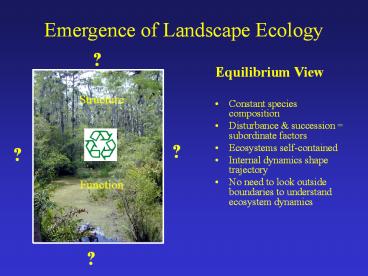Emergence of Landscape Ecology - PowerPoint PPT Presentation
Title:
Emergence of Landscape Ecology
Description:
No need to look outside boundaries to understand ecosystem dynamics? Structure? Function? Emergence of Landscape Ecology Dynamic View Disturbance & ecosystem ... – PowerPoint PPT presentation
Number of Views:185
Avg rating:3.0/5.0
Title: Emergence of Landscape Ecology
1
Emergence of Landscape Ecology
?
- Equilibrium View
- Constant species composition
- Disturbance succession subordinate factors
- Ecosystems self-contained
- Internal dynamics shape trajectory
- No need to look outside boundaries to understand
ecosystem dynamics
?
?
?
2
Emergence of Landscape Ecology
- Dynamic View
- Disturbance ecosystem response key factors
- Disturbance counter equilibrium
- Ecosystems NOT self-contained
- Multiple scales of processes, outside inside
- Essential to examine spatial temporal context
3
Scale
- Whats the big deal?
- Seminal pubs
- Allen Starr (1982) Hierarchy perspectives
for ecological complexity - Delcourt et al. (1983) Quaternary Science
Review 1153-175 - ONeill et al. (1986) A hierarchical concept of
ecosystems
4
Ecological Scaling Scale Pattern
- Acts in the ecological theatre (Hutchinson 1965)
are played out across various scales of space
time - To understand these dramas, one must select the
appropriate scale
Speciation Extinction
Species Migrations
Secondary Succession
Windthrow
Fire
Treefalls
Recruitment
5
Ecological Scaling Scale Pattern
- Different patterns emerge, depending on the scale
of investigation
Regional Scale (thousands of ha)
Local Scale (4 ha plots)
6
Ecological Scaling Components of Scale
- Grain minimum resolution of the data
- Cell size (raster data)
- Min. polygon size (vector data)
- Extent scope or domain of the data
- Size of landscape or study area
7
Ecological Scale
- Scale characterized by
- grain smallest spatial resolution of data
- e.g., grid cell size, pixel size, quadrat size
(resolution) - Fine Coarse
8
Ecological Scale
- Scale characterized by
- extent size of overall study area (scope or
domain of the data) - Small Large
9
Ecological Scaling Components of Scale
- Minimum Patch Size min. size considered gt
resolution of data (defined by grain) - Size of landscape or study area
10
Ecological Scaling Definitions
- Ecological scale cartographic scale are exactly
opposite - Ecological scale size (extent) of landscape
- Cartographic scale ratio of map to real distance
11
Scale in Ecology Geography
- ecological vs. cartographic scale
Ecology Geography
Small (Fine) Fine resolution Small Extent Coarse resolution Large Extent
Large (Broad) Coarse resolution Large extent Fine resolution Small extent
12
Scale in Ecology Geography
- ecological vs. cartographic scale
- e.g., map scale
- 124,000 vs. 13,000
- fine vs. coarse
- large vs. small extent
13
124,000
1200,000
14
Ecological Scaling Components of Scale
- Grain and extent are correlated
- Information content often correlated with grain
- Grain and extent set lower and upper limits of
resolution in the data, respectively.
15
Ecological Scaling Components of Scale
- From an organism-centered perspective, grain and
extent may be defined as the degree of acuity of
a stationary organism with respect to short- and
long-range perceptual ability
16
Ecological Scaling Components of Scale
- Grain finest component of environment that can
be differentiated up close - Extent range at which a relevant object can be
distinguished from a fixed vantage point
Extent
Grain
Coarse
Fine
Scale
17
Ecological Scaling Components of Scale
- From an anthropocentric perspective, grain and
extent may be defined on the basis of management
objectives - Grain finest unit of mgt (e.g., stand)
- Extent total area under management (e.g.,
forest)
18
Ecological Scaling Components of Scale
- In practice, grain and extent often dictated by
scale of available spatial data (e.g., imagery),
logistics, or technical capabilities
19
Ecological Scaling Components of Scale
- Critical that grain and extent be defined for a
study and represent ecological phenomenon or
organism studied. - Otherwise, patterns detected have little meaning
and/or conclusions could be wrong
20
(No Transcript)
21
Scale Jargon
- scale vs. level of organization
22
(No Transcript)
23
(No Transcript)
24
(No Transcript)
25
Ecological Scaling Implications of Scale
- As one changes scale, statistical relationships
may change - Magnitude or sign of correlations
- Importance of variables
- Variance relationships
26
(No Transcript)
27
(No Transcript)
28
Implications of Changes in Scale
- Processes and/or patterns may change
- Hierarchy theory structural understanding of
scale-dependent phenomena
Example Abundance of forest insects sampled at
different distance Intervals in leaf litter,
29
Implications of Changes in Scale
Insects sampled at 10-m intervals for 100 m
30
Implications of Changes in Scale
Insects sampled at 2000-m intervals for 20,000 m
31
Identifying the Right Scale(s)
- No clear algorithm for defining
- Autocorrelation Independence
- Life history correlates
- Dependent on objectives and organisms
- Multiscale analysis!
- e.g., Australian leadbeaters possum
32
Multiscale Analysis
- Species-specific perception of landscape features
scale-dependent - e.g., mesopredators in Indiana
- Modeling species distributions in fragmented
landscapes
33
Hierarchy Theory
- Lower levels provide mechanistic explanations
- Higher levels provide constraints
34
Scale Hierarchy Theory
- Hierarchical structure of systems helps us
explain phenomena - Why? next lower level
- So What? next higher level
- minimum 3 hierarchical levels needed
35
Constraints (significance)
Level of Focus (level of interest)
Components (explanation)
36
Constraints
Community
Why are long-tailed weasel populations declining
in fragmented landscapes?
Population
Components
Individual
37
Constraints
Community
Why are long-tailed weasel populations declining
in fragmented landscapes?
Population
Small body size mobility
Individual
38
Predators Competitors Prey distn
Community
Why are long-tailed weasel populations declining
in fragmented landscapes?
Population
Components
Individual
39
Scale Hierarchy Theory
- Change scale
- influential variables might not change, but
- shift in relative importance likely
Example Predicting rate of decomposition of
plant matter Local scale lignin content
environ. variability Global scale temperature
precip.































